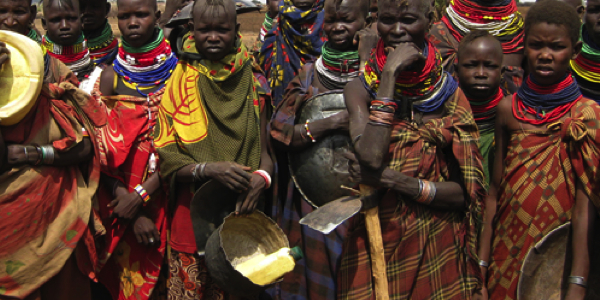Over the last decade, approximately $90 billion was spent by international donors in just 9 countries, accounting for almost 50% of all humanitarian assistance during this period. In the same decade, 75% of USAID humanitarian assistance was spent in just 10 countries.
USAID defines resilience as ‘the ability of people, households, communities, countries and systems to mitigate, adapt to and recover from shocks and stresses in a manner that reduces chronic vulnerability and facilitates inclusive growth’. USAID’s resilience efforts focus on people and places at the intersection of chronic poverty and exposure to shocks and stresses that are subject to recurrent crises. (See Refs 1 and 2.)
Joint Planning Cells…and beyond
Joint Planning Cells (JPCs) in the Horn and Sahel have provided an organizational home for bringing together the humanitarian and development sides of USAID for joint analysis, planning and implementation. Efforts are also underway to explore embedding this approach in existing institutions and processes.
Resilience in USAID

Impetus and Rationale
In late 2011 and early 2012, building resilience to recurrent crises emerged as a shared, cross-bureau priority within USAID. This was prompted by large-scale humanitarian emergencies in the Horn of Africa and Sahel and the collective recognition by USAID, other donors, governments, regional institutions, and a wide array of humanitarian and development partners that continuing to treat recurrent crises as acute emergencies – and chronic vulnerability as a perpetual humanitarian risk – is extremely costly.
This cost includes loss of lives, livelihoods, dignity and aspiration. The famine in Somalia in 2011 provides an extreme and devastating example. Recurrent crises also negatively impacts national and regional economies as evidenced by the estimated $12 billion in livestock losses associated with drought in Kenya between 2008 and 2011. The over $1.5 billion the USG contributed to support humanitarian efforts in the Horn and Sahel in 2011-2012 alone further underscores the recurrent cost in budget terms.
What’s New (and What’s Not)?
The concept of resilience is not new and has a long history in ecology, social psychology and other disciplines. Moreover, all ‘good’ development and most of what is done under the auspices of humanitarian-funded recovery, rehabilitation or Disaster Risk Reduction (DRR) efforts contribute to resilience as defined by USAID. What is new is the use of resilience (by USAID and others) as an analytic, programmatic, organizing concept for addressing the underlying causes of chronic vulnerability and recurrent crisis. Signature features of USAID’s resilience efforts that stand out in this regard include:
Resilience deficit areas (and people) as a development priority—Far greater attention to, and investment in, chronically vulnerable people and places that are subject to recurrent crisis and that have been historically neglected by development actors and policy. In the Horn and Sahel, these areas are characterized by the recurrent need for large-scale, external humanitarian response.
Shocks as Perennial Features—An explicit analytic recognition that shocks, such as droughts and floods, are perennial features of these landscapes, not anomalies, and that the impact of these shocks is exacerbated by longer-term stresses such as population pressure and climate change (Ref 3). As a result, far more programmatic attention is now being given to reducing risk and enhancing adaptive capacity as sources of dynamic stability, as well as the centrality of governance and women’s empowerment (both broadly conceived) as means to these ends (see Ref 4).
Leveraging Humanitarian and Development Perspectives and Resources – Joint analysis by diverse, multi-sector humanitarian and development teams using a systems approach to understand dynamics of change, the inter-connectedness (and multitude) of causes of risk and vulnerability, and leverage points for reducing (and managing) risk, enhancing adaptive capacity and facilitating inclusive growth. Joint planning informed by these analyses has resulted in the strategic sequencing, layering and integration of humanitarian and development programs and policy actions in support of shared resilience-building aims.
- Joint analysis defining the problem and the types of solutions and resources needed rather than the types of resources available defining the parameters of analysis.
- Sequencing, layering and integration of humanitarian and development efforts down to community and household levels in focus geographies identified through joint analysis.
- Joint humanitarian and development team co-management of partners to foster strategic coalitions and collective impact (Ref 5).
International Partnerships – Enhanced coordination, planning and integration of efforts among a range of other development and humanitarian actors – including governments, regional institutions and international partners, including donors, UN agencies, NGOs, academic institutions, the private sector, civil society – in support of resilience-building efforts.
- Support to regional institutions to fulfill their mandates to convene, coordinate and lead resilience efforts in the Horn and Sahel.
- Support to national governments to fulfill their mandates to convene, coordinate and lead resilience efforts in their respective countries.
- Establishment of the Global Alliance – a strategic partnership between development partners, regional institutions and governments to drive resilience efforts in the Horn/Sahel.
- Launch of the Higher Education Solutions Network (HESN) – Resilient Africa Network (RAN); a consortium of 22 African universities focused on applied research on resilience.
The Institutional(ization) Challenge
Institutionalizing and operationalizing joint humanitarian and development analysis, planning and action in support of resilience efforts in regions and countries subject to recurrent crisis remains a significant challenge and one agency leadership and committed to facing head on. Joint Planning Cells in the Horn and Sahel have provided a temporary, organizational fix as waiting for broader institutional change or program cycle opportunities was simply not an option (see box 2). Looking forward, however, the vision of the agency’s Resilience Leadership Team (RLT) is to further and more sustainably institutionalize resilience as an analytic, programmatic and organizing concept by embedding it in existing institutions and processes. Country Development Cooperation Strategy and program design processes in countries subject to recurrent crises provide a prominent example.
USAID’s organizational architecture also presents a challenge. To begin to address this, a multi-bureau, multi-office Resilience Leadership Team (RLT) and a 3 person Resilience Secretariat (RS) have been established to facilitate continued intra-agency collaboration at the leadership and technical levels respectively. Both are supported by a Technical Working Group (TWG) comprised of technical experts drawn from bureaus and offices throughout the agency. Key objectives in 2013-2014 include institutionalizing resilience in agency processes, delivering (and measuring) results in the Horn and Sahel, expanding resilience efforts into Asia, exploring resilience in fragile states and continuing to forge new partnerships. This RLT, RS, TWG structure also serves as a hub for resilience and related efforts happening throughout the agency.
Measurement and Learning
As USAID’s definition suggests, resilience and its measurement are complex and multi-dimensional. A limited set of topline indicators have been identified as summative measures of this complexity;
- Humanitarian assistance needs normalized by severity of shock (drought) (Ref 6)
- Depth of poverty (DoP)
- moderate to severe hunger as measured by the household hunger scale (HHS)
- Global Acute Malnutrition (GAM)
DoP and GAM offer important contextual complements to Feed the Future’s (FTF) Poverty Prevalence and Stunting indicators and can be derived from any FTF baseline data. HHS is FTF’s economic resilience indicator. Humanitarian assistance needs speak directly to the economic rationale for investing in resilience, but is problematic as a stand-alone indicator for reasons outlined in an accompanying technical note on resilience measurement.
Measures of mitigation, adaptive and recovery capacities are also required, as are community and systems level measures of these capacities. Methods for capturing these aspects of resilience are being developed and tested by USAID and through USAID’s participation in a global Technical Working Group on Resilience Measurement under the Food Security Information Network (FSIN). Both are described in the technical note referenced above.
References
- The terms systems includes, but is not limited to social, ecological and economic systems.
- See criteria for prioritization in Building Resilience to Recurrent Crisis: Policy and Programming Guidance (2012).
- The term shock also includes idiosyncratic events such as a health crisis within an individual household.
- Governance includes NRM, conflict management, and disaster risk management and the interaction between formal and informal governance structures in these and other substantive areas.
- www.ssireview.org/articles/entry/collective_impact
- This measure is intended to capture changes in assistance needs between significant drought episodes rather than within a single drought episode (recognizing that it is increasingly difficult to distinguish between droughts).
 About the Author, Greg Collins
About the Author, Greg Collins
Member of Peace
Greg Collins is a technical advisor in the United States Agency for International Development’s (USAID) Bureau of Food Security and Deputy Director of the agency’s cross-bureau Resilience Secretariat. Greg was based in Nairobi (with Food-for-Peace) during the 2011 drought emergency and helped lead the development of USAID’s Horn of Africa resilience strategy in 2012. He also led a DC-based technical team supporting the development of USAID’s Sahel resilience strategy in 2012-13.
Prior to coming to USAID, Greg worked as technical advisor for various UN agencies (FAO, WFP, UNICEF) and NGOs in Somalia, Kenya, Ethiopia, South Sudan, Uganda, Malawi, Tanzania, Burundi, Egypt, Mozambique, South Africa, Namibia, and Yemen .
Greg holds an MPH from Tulane University with emphasis on food security and monitoring and evaluation and a PhD in Economic Sociology from UC Davis. Greg’s doctoral research focused on the emergence (and resilience) of Somalia’s telecommunications industry in the wake of state collapse and how Somali telecoms firms used decentralized, clan-embedded controls and practices such as cross-clan partnerships and shareholding to protect private property, enforce contracts and resolve disputes in the absence of state institutions for doing so.
